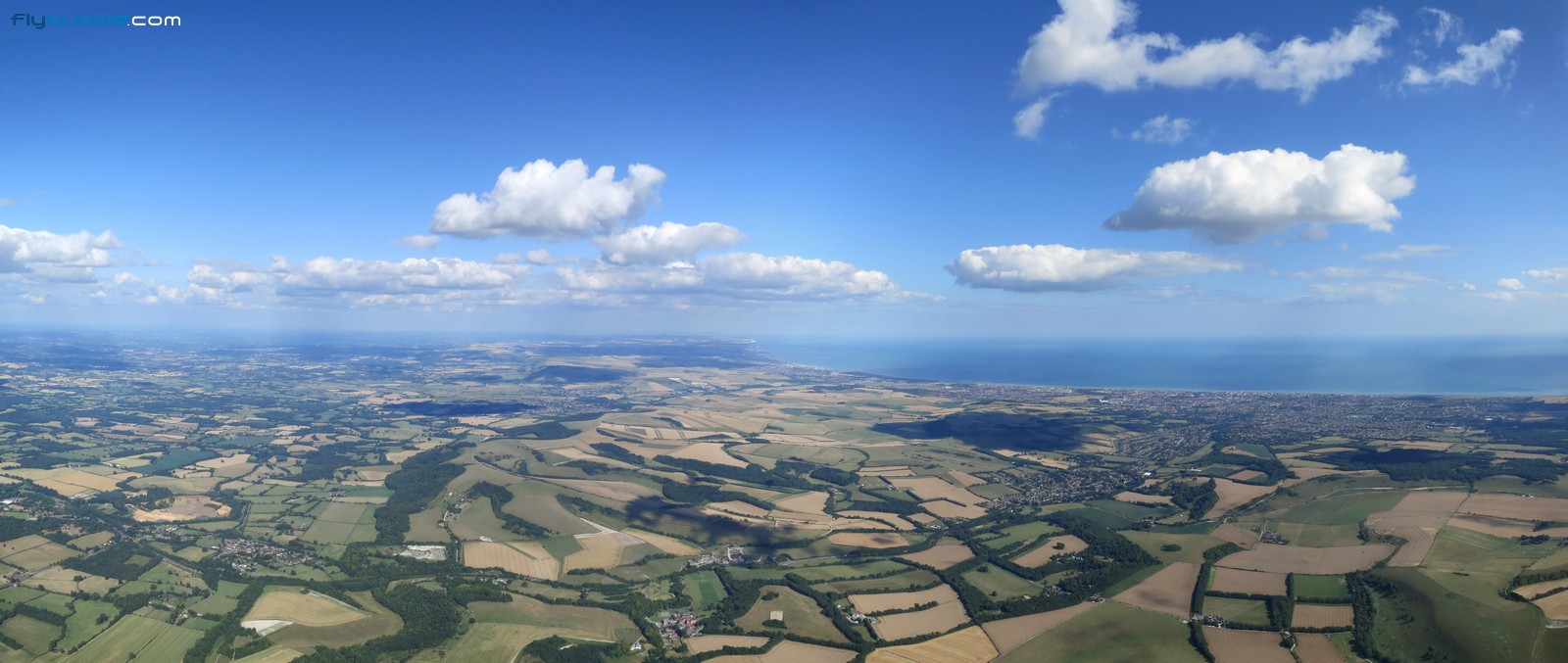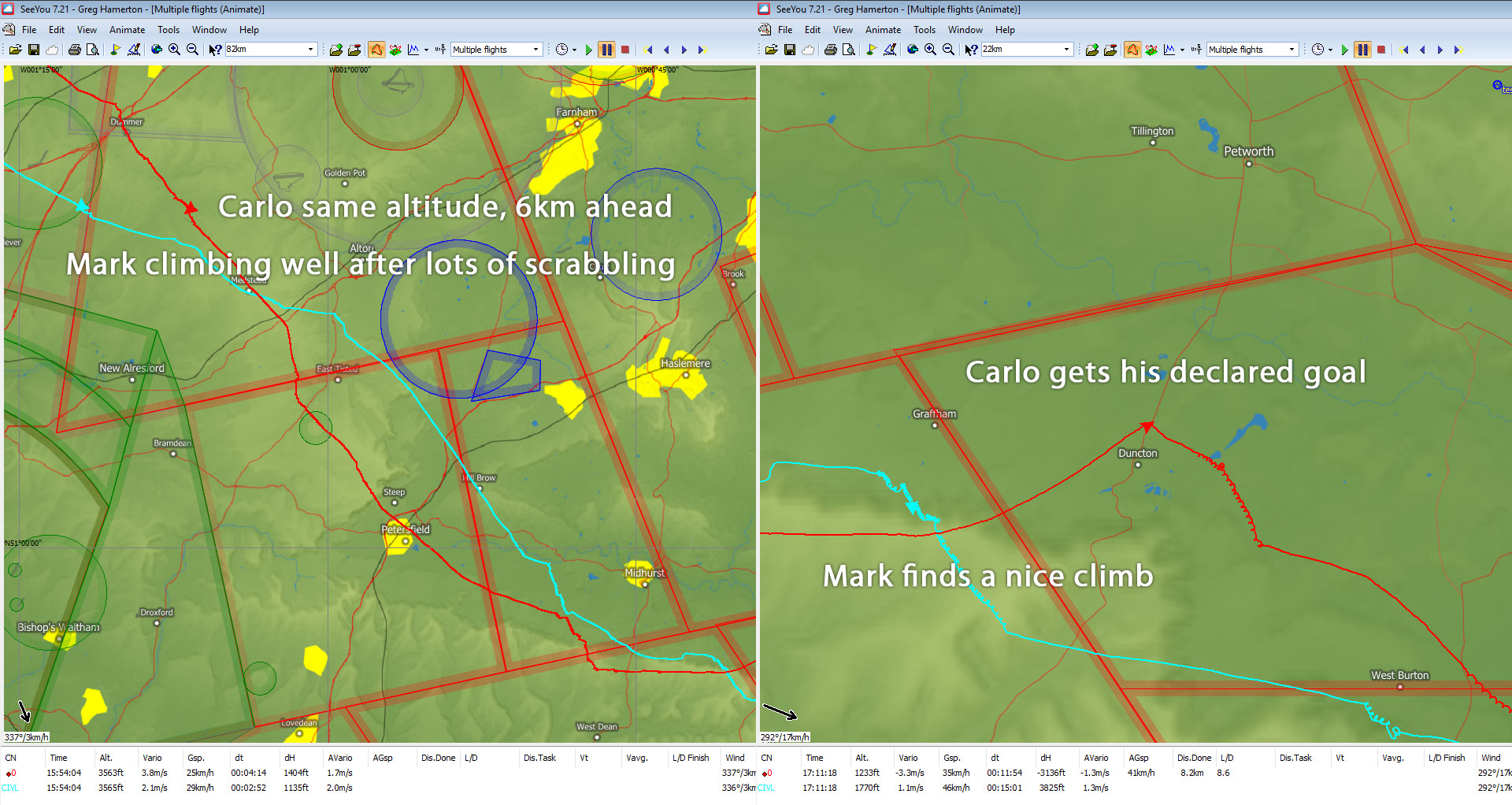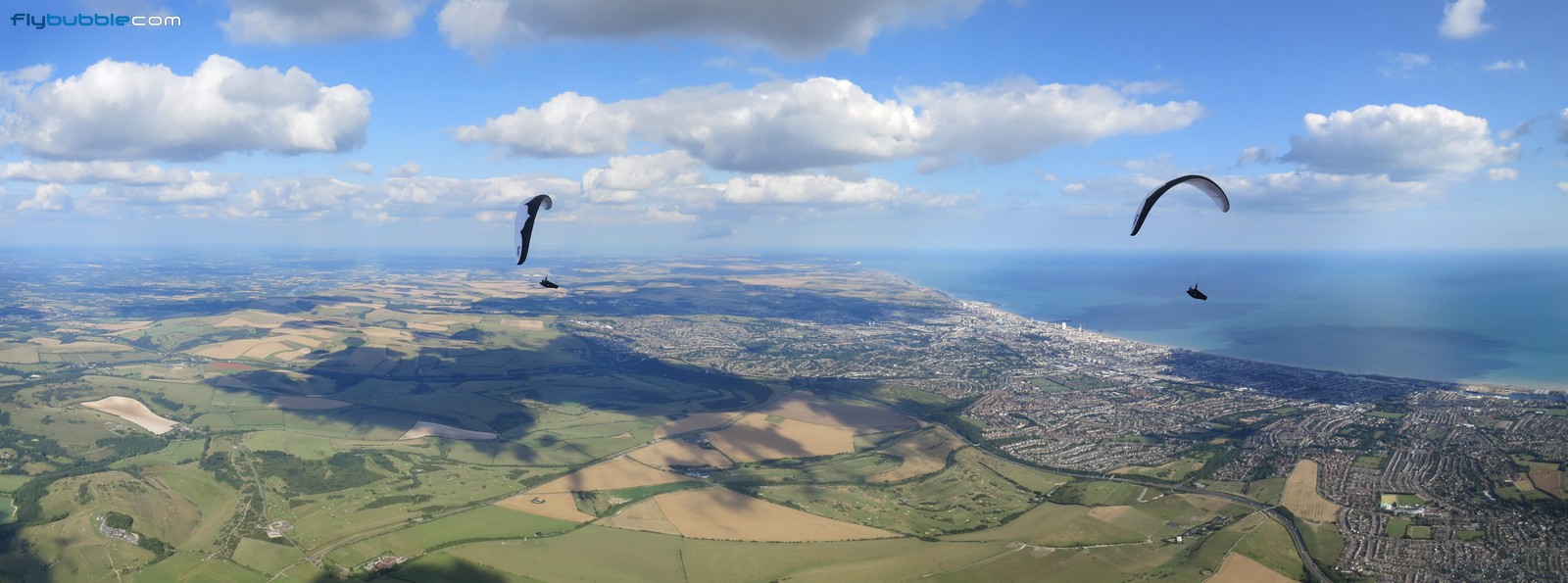
Getting the most out of a good XC day often comes down to a simple decision: do you leave the hill as soon as you can (and try to stay up all day) or do you wait till it's good and blaze a trail on speedbar to cover more ground during the strong part of the day?
Flybubble's Carlo Borsattino recounts his decisions and tactics on an epic flight from Selsley Common hill near Stroud in Gloucestershire to near Eastbourne in East Sussex, when his leading position on his sports class wing (Skywalk CAYENNE5, EN C) was put to the test against the relentless racing of Mark Watts on his competition wing (Ozone Enzo 2, CCC).
By Carlo Borsattino
Having already enjoyed some of the best XC flights I've ever had in the UK spring and early summer, you might suppose that the XC monkey would get off my back and let me be. Quite the opposite, in fact! These experiences were so amazing that I just wanted more.

The forecasts for Friday 30th July were epic. It didn't take long to fill the Flybubble van up with other hopeful XC addicts. We headed for Selsley Common, near Stroud in Gloucestershire, where there was big XC potential for the forecast wind direction. By 9 am the sky was already looking great!
.jpg)
As we drove I recalled the last time I flew XC from Selsley. Whilst looking for lift in scrappy conditions, I was lucky enough to hook into a bubble which no one else got. It took me up high, and I decided to leave the hill first, on my own. This turned out to be a dumb idea as I glided all the way to the ground, several kilometres from launch, soon to be joined by Graham Steel who thought I must've spotted something good to have rushed off so early. Nope; I just got carried away. Those who left the hill later played it more cautiously, taking a different line, and flew much farther.
On the hill we eyed the glorious-looking sky with nervous excitement. We discussed flight plans and set our own goals. I wanted to aim for Devils Dyke (170km), but I'd tried for that last year and ended up landing a few km short so I decided to set it at 165km.

^ mmm, gimme some of that fluffy stuff!
I've only flown Selsley Common a few times, so don't know the site well, but each time I've found it quite rough, especially around launch, and rather tricky to get up and away from. The hill itself is only 300 feet top to bottom and doesn't seem to generate a great deal of ridge lift. It has a line of big, leafy trees running most of the way along the bottom, which probably explains most of the turbulence around launch. The soarable part of the ridge is short, which also means that it gets crowded, and there is a Venturi effect around the north end of the ridge as the wind accelerates into the valley downwind. All good incentives to get up and away as quickly as possible!
Getting away
The lift was small, broken and short lived. After half an hour of scurrying about in a busy sky on my Cayenne 5, I finally found a better climb out front of the hill. Graham and Phil Wallbank soon joined me, and we took the climb up and back, drifting fast. As we approached the point of no return Phil left and headed back for the hill, whilst Graham and I carried on together. So, yet again, we found ourselves in the exactly situation we had sworn to avoid after the last time we bombed out together: leaving the hill first, just the two of us! We managed to stay high as we left the hill, and the sky looked good downwind...

^ It's good to have friends in high places
We both topped out at 4900 ft and pushed on towards the next good-looking cumulus. We picked up our next climb north of Tetbury. Meanwhile Mark was catching his own thermal from Selsley and would soon be giving chase to us. He usually leads and really doesn't like to be left behind on his Enzo 2.
Graham and I played it safe and kept working climbs to stay high as we passed first north then east of Malmesbury, where we picked up another climb to base, at around 5 grand.

^Pretty shady ahead for Graham Steel (green wing on right) and I
Mark glided faster than us and steadily reeled us in, closing the gap by 7km in the first hour. Graham and I had the advantage of flying together, helping each other find climbs, so we suffered fewer low points.
But sink finds everyone. As we approached Swindon our glide took us down to around 2000ft. Here the clouds were harder to read and the climbs were disorganised. As we searched for better climbs, we could see some paragliders struggling to get up on Liddington Castle, east of us. Graham found a good core and gained several hundred feet on me. I then took a better line under the next cloud which left me several hundred feet above him. By Marlborough we were circling together again.

Speeding ticket
We picked up a 4 m/s climb to 5500ft, whilst Mark has to settle for a weaker climb behind us. I decided it was time to pick up pace, so I glided towards Combe Gibbet, whilst Graham kept climbing behind me. The gamble paid off: after a sinky glide, a good climb! By the time Graham reached me all he found was sink, so he was soon low and gliding. Once I reached 500ft below airspace the lift weakened so I pushed on.
Graham flew more conservatively, climbing higher but covering less ground, so when he joined my next thermal he was 800ft lower than I. I felt rather pleased with my decision-making. Pride comes before a fall, so they say.
As I approached the town of Dummer I wasn't feeling clever anymore. Down to 2300ft after a long sinky glide, I was forced to work a crappy climb as Graham looked down from aloft. My attempt to go faster had been thwarted. The lift I found fizzled out.
I eventually found a climb to the west of Lasham gliding field, and Graham joined me at roughly the same height. All this mincing about had allowed Mark to close the gap. Time to pick up the pace! Again, I left the climb sooner than Graham, as it weakened at around 4700ft, to head towards the next cloud, and keep well clear of the airspace. Will I ever learn?

^ The bigger the cloud, the bigger the shade...
I realised too late that the next cloud was significantly bigger - and therefore significantly farther - than I had judged it to be, which meant that if I didn't get anything from Four Marks (I didn't) then I was going to end up getting low just where I really didn't want to be: in the big shady area underneath it.
My heart sank as the sink tone of my vario engaged and I analysed my lack of options. It wasn't looking good, with heavy shade all around! One minute I'm leaving a climb to try and keep a good margin from the airspace; a few minutes later it looks like I might be landing. On the positive side I had only one option: a combine harvester working a field south of Four Marks. In the shade.
I found some lumpy air with small spikes of lift, so I searched around, gradually losing height. OK, so there might be some lift going off nearby but where? It's very easy to make the wrong move in this kind of situation and quickly end up on the ground. The worst thing to do is to get stressed out since this is likely to negatively affect your performance, making it more likely that you will land. So I relaxed and focused on maximising my chances of finding the lift, trying my best to be a thermal diviner, tuning my senses to the wing and the air, feeling where the thermal source might be.
.jpg)
^ The subtle art of listening to the glider ... what's the Cayenne 5 saying (apart from 'Orange'?)
I felt the glider being gently pulled cross downwind, to the south, possibly being drawn in (I hoped) by rising air, so I let it lead me there. After flying through increased sink for a several seconds I sensed the glider pulling forwards for a few seconds, then felt that joyous uplifting tug you get as the wing bites into a thermal core. Yeeha, Granma!
Squealing at the ceiling
One minute it looks like I might be landing; a few minutes later I'm sky-rocketing towards cloudbase, having to pull in big-big ears with full speed bar to stay out of the 5500ft class A airspace above me. It's a silly game, but I love it!
Beeep-beeep-beeeep! It wasn't working: I had to resort to something more radical. So I quickly let out the ears, came off the bar and threw in a steep spiral dive, focusing hard on the vario and altitude readings on my Oudie as the world goes round and around, ablur. Checking my instruments later, this took my sink rate from around +3 m/s up to around -15m/s down.
I held it in for 1000ft, rocketted out of the spiral and found myself fast approaching the airspace again. I like plenty of margin for error, so I immediately went back to big-big ears with speed bar, heading southeast towards the nearest blue sky (hopefully sink, or at least no lift). Despite gliding on a 'cut-down' glider, I soon surpassed 5000ft, climbing at over 2 m/s in the wide area of lift, so had to spiral again to get myself back down.
This game of airspace aversion continued until I finally scooted out from under the clouds and glided on towards Harting Down.

^ Big block of shade ... no problem if you're high enough!
I could see that Mark and Graham had linked up behind me. Mark looked very low; I later learned he got down to about 500ft above ground at this point, but he wasn't out of the game ... he is a master at low saves! I took a climb near the South Downs then followed the hills eastwards. Mark and Graham took a climb west of Midhurst, then gave chase.
The good-looking cloud downwind looked too far away to reach: if I went for it I risked gliding into another shady situation. There was an active-looking cumulus to the northeast of me, which was a better position for where I wanted to go bearing in mind the wind direction. A tractor was working a brown field upwind of it. Dust trailed up towards the cloud. I changed course cross-upwind.
I reached where I hoped to find lift downwind of 'my tractor'. Nothing. I ran downwind towards the cloud. More nothing. I was getting low. Looking back I saw Mark and Graham climbing merrily. Think positive, I told myself. The lift is here, focus and find it.
My wing surged. The lift was good, soon averaging around 3 m/s with peaks over 7! Of course I was now fast approaching airspace again (now at 5000ft). There were good looking cumulus clouds ahead of me, and the day was getting long, so I pushed on.

^ The downs, the clouds, the sea ... will I ever tire of this view?
I got a nice booster just before Amberly, passed the Parham gliding club, and picked up another climb off the base of the downs south of Storrington.
Mark chose the same track as I whilst Gray pushed northeast, cross-upwind, towards a good cumulus over Washington. This worked well but was an unnecessary diversion as Mark and I found a good climb just east of Steyning, a climb which Gray picked up a few minutes later.
I was now within spitting distance of my 165km declared goal, so I left the climb to push north and clip the cylinder, claiming my UKXC League score of 222 thanks to declared goal multiplier bonus.

Job done, but who could waste good XC flying? I glided on to Truleigh Hill, the most westerly flying site of the SHGC. It's very satisfying to fly XC to reach your local flying area and pass by your regular flying sites, especially when you see your friends flying on them!

^ Mark ... and Mark, on his Enzo Enzo, over Truleigh. Truly.
I found a nice climb over Truleigh, Mark joined me and we thermaled together for a few minutes, soaking up the moment and admiring the fabulous views all around us. It had taken Mark almost 5 hours to close the gap I had made by leaving the hill first. I didn't know what Mark planned to do from here, but guessed that he'd probably want to fly as far as possible, as did I. How much farther could we go?
The last grasp
Looking at the cloud erosion it was clear that the sea breeze had already edged its way inland to our south and east, but not all that far. I decided to head east, keeping more away from the sea breeze, whilst Mark headed straight for the sea breeze, hoping to find a lifty line in the convergence.
It's a dicey game playing with the sea breeze; sometimes you get lift (sometimes a lot) yet other times you end up dropping down into the cold, inert sea air and get decked (with perhaps a nasty pasting on the way down). This time, Mark got the former, whilst I had to work harder to stay in the game. To reach Firle I had to work three climbs whilst Mark only had to work one. Meanwhile Gray chose a similar line to me but glided from 5000ft all the way to the ground, landing north of Brighton.
Although now ahead of me, Mark dropped into the sea air by aiming for his cunning goal (High & Over), so it was going to be final glide for him to Polegate. As he passed over the 196.8km point his instrument helpfully declared "Task Started." He'd set it the wrong way around! No Tesco points for him.

^ The seabreeze front is visible (tendrils left of centre) pushing in from Eastbourne
I connected with the leading edge of the sea breeze front at Firle. After working hard to find a decent climb for a few minutes, suddenly the lift became constant and strong, hoiking me skywards. I was hoping for some nice mellow climbs to finish off the day; instead I was in one of the most boisterous and demanding climbs on the whole flight! I managed to escape the lift at around 5200ft, just below the airspace. From there I glided over Arlington Reservoir. Before I could say "stable sea air" I had landed, in the middle of the Pevensey Levels.

Selsley Common was lost in the haze of the setting sun, over 200km away. I was glad I had taken the risk and left the hill first, it had earned me 16km. That advantage was slowly eroded by the faster glides of the Enzo 2, but staying in the air for longer at the end of the day had taken me into the lead again, if only by a kilometre or two. It had been nearly seven hours of glorious flying in UK's best conditions.
Going first or going fast? What really matters is going flying!
More details
Carlo was flying Skywalk Cayenne 5 (EN C)
Mark was flying Ozone Enzo 2 (CCC)
Graham was flying Niviuk Icepeak 7 (EN D)


^ How to start the day right
